A research team led by Professor Wu Xiaojun from the Terahertz International Research Center (TIRC) at Hangzhou International Innovation Institute (H3I) of Beihang University recently made breakthroughs in developing terahertz (THz) sources that combine high average power, high pulse repetition rate, and high brightness, while maintaining low cost. The team adopted tilted-pulse-front (TPF) techniques in a lithium niobate crystal pumped by a 1030nm industrial-grade femtosecond laser from Ultron Photonics Technology Co., Ltd.
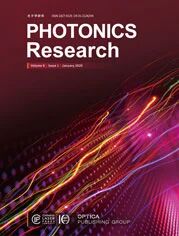
To address the limitations of low pulse repetition frequency and average power in conventional strong-field THz sources, researchers have developed a high-power strong-field THz source with an average power exceeding 64.5mW by using a lithium niobate crystal pumped by a domestically produced industrial-grade long-pulse ytterbium (Yb)-doped laser. This has provided strong source support for cross-disciplinary applications of strong-field THz spectroscopy and imaging in aerospace, non-destructive testing, integrated circuits, quantum information, and biomedicine. The related achievements were published in Photonics Research under the title "Room-temperature high-average-power strong-field terahertz source based on an industrial high-repetition-rate femtosecond laser". H3I is the lead institution.

Original link:https://doi.org/10.1364/PRJ.563949
Research background
Free-space strong-field THz pulses have advantages such as high peak electric fields (>100kV/cm), high-pulse magnetic fields (at the sub-tesla scale), short pulse durations (<1ps), and distinctive frequency bands (0.1-10THz). These pulses can control electron trajectories, excite magnetic resonances, modify phonon coupling, and manipulate spin dynamics. They have shown significant promise in fundamental scientific research and hold greater potential in industrial applications. However, the key bottleneck hindering the development and application of strong-field THz technology is the lack of high-efficiency, high-beam quality, and high-stability THz sources.
There are many methods to generate THz radiation, but it is not easy to achieve high intensity. The interaction between femtosecond lasers and matter is one of the most effective methods for generating strong-field THz electromagnetic pulses, including but not limited to nonlinear crystals, gas plasmas, and spintronic THz emission based on magnetic nanofilms. Among these methods, generating THz radiation with lithium niobate pumped by a traditional titanium sapphire femtosecond laser amplifier has gradually become the mainstream approach for strong-field THz sources, because of the crystal’s large nonlinear coefficient, high generation efficiency, and excellent stability. Using this scheme, the research team led by Wu Xiaojun at Beihang University and their collaborators have achieved the first millijoule- and ten-millijoule-level lithium niobate-based THz sources, increasing the long-standing international record of 0.4mJ in single-pulse energy by two orders of magnitude (Laser Photonics Rev. 2021, 15, 2000, 295, original link: DOI: 10.1002/lpor.20000295; Advanced Material 2023, 35, 2208947, original link: https://doi.org/10.1002/adma.202208947). More than 80 high-level relevant academic papers have been published. Their achievements have been repeatedly rated by international peers as "world records" and "milestone progress".
However, more advanced precision measurement technologies and broader industrial applications require not only high single-pulse energy, but also new THz sources that combine high average power, high pulse repetition rate, and high brightness, while maintaining low cost. These applications include THz-ARPES, THz-SNOM, and THz-STM. In addition, high-average-power strong-field THz sources can deliver peak signal strengths that are three to six orders of magnitude higher than those of conventional weak-field THz time-domain spectrometers. Besides high-quality and fast THz imaging and THz-CT, they are expected to unlock a wider range of industrial applications previously constrained by insufficient THz photon flux.
One of the most promising ways towards the above goals is to use recently developed high-average-power and low-cost industrial-grade Yb-doped femtosecond lasers to pump lithium niobate crystals and generate high-average-power strong-field THz radiation. However, such high-power lasers face an inherent trade-off between pulse repetition frequency and single-pulse energy: once the repetition frequency exceeds 10kHz or even 100kHz, the single-pulse energy seldom surpasses 5mJ, let alone higher values. Moreover, it remains challenging to attain short pulse durations while maintaining high single-pulse energy. These interdependent constraints complicate efficient THz generation in lithium niobate. In addition to satisfying stringent phase-matching conditions, one must mitigate the efficiency degradation caused by excessively long pulses and avoid crystal damage induced by the high pump powers required.
Innovation points
Using domestically developed high-power, long-pulse, industrial-grade, low-cost femtosecond lasers to pump lithium niobate crystals, researchers compared the efficiency and beam quality of THz radiation generated by two TPF techniques: one based on transmission grating and the other on reflective echelon mirrors. It was found that the grating-type TPF technique was more suitable for long-pulse, high-power laser pumping. The study revealed the mechanism behind THz generation efficiency saturation in this process and proposed a new synergistic compensation mechanism for linear efficiency. A high-average-power THz output of 64.5mW was achieved, laying a strong source foundation for the widespread application of THz techniques.
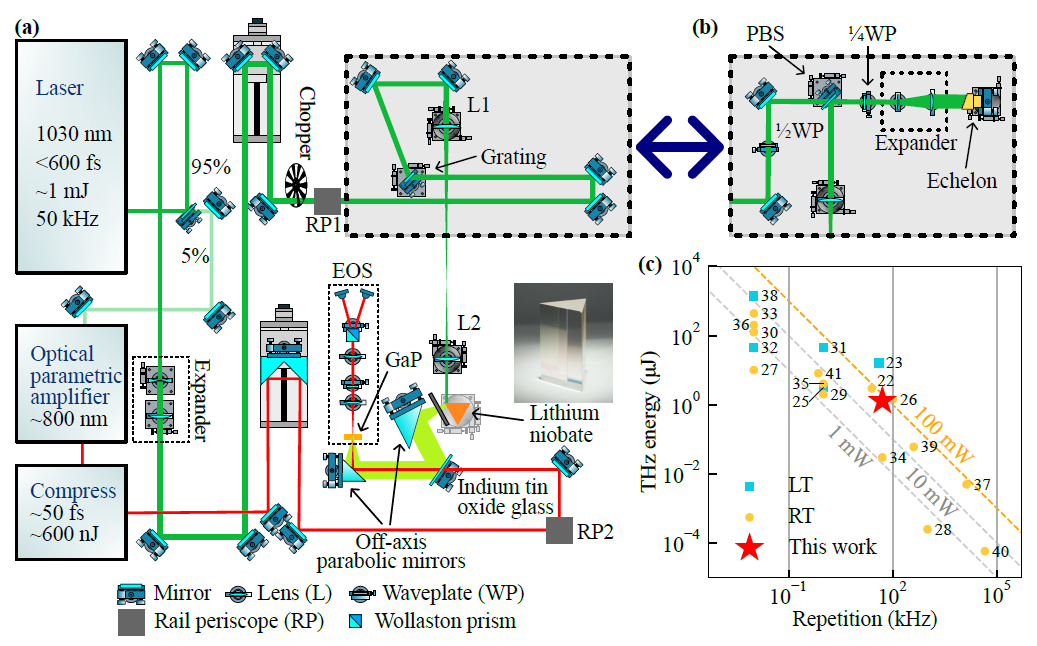
Figure 1: Schematic diagram of high-power strong-field THz generation and detection devices. (a) Based on grating-type TPF techniques; (b) based on echelon-type TPF techniques; and (c) comparison and statistics of output power of high-power THz sources in recent years.
Figure 1 shows a schematic diagram of the experimental setup for generating and detecting high-power strong-field THz sources. In the optical path design, two TPF techniques – one using a transmission grating and the other a reflective echelon mirror – are devised as two modules for comparative study. The pump laser has a center wavelength of 1030nm, pulse duration of less than 600fs, single-pulse energy of around 1mJ, and a repetition rate of 50kHz. About 95% of the laser energy is used to pump a lithium niobate for THz generation, while the remaining energy is converted into the probe pulse (50fs, 600nJ) via an optical parametric amplifier for electro-optic sampling. The generation of THz radiation is collected by off-axis parabolic mirrors and combined with the probe beam through an ITO glass for electro-optic sampling to obtain THz time-domain waveforms and spectral widths. All experiments were conducted at room temperature for the crystals.
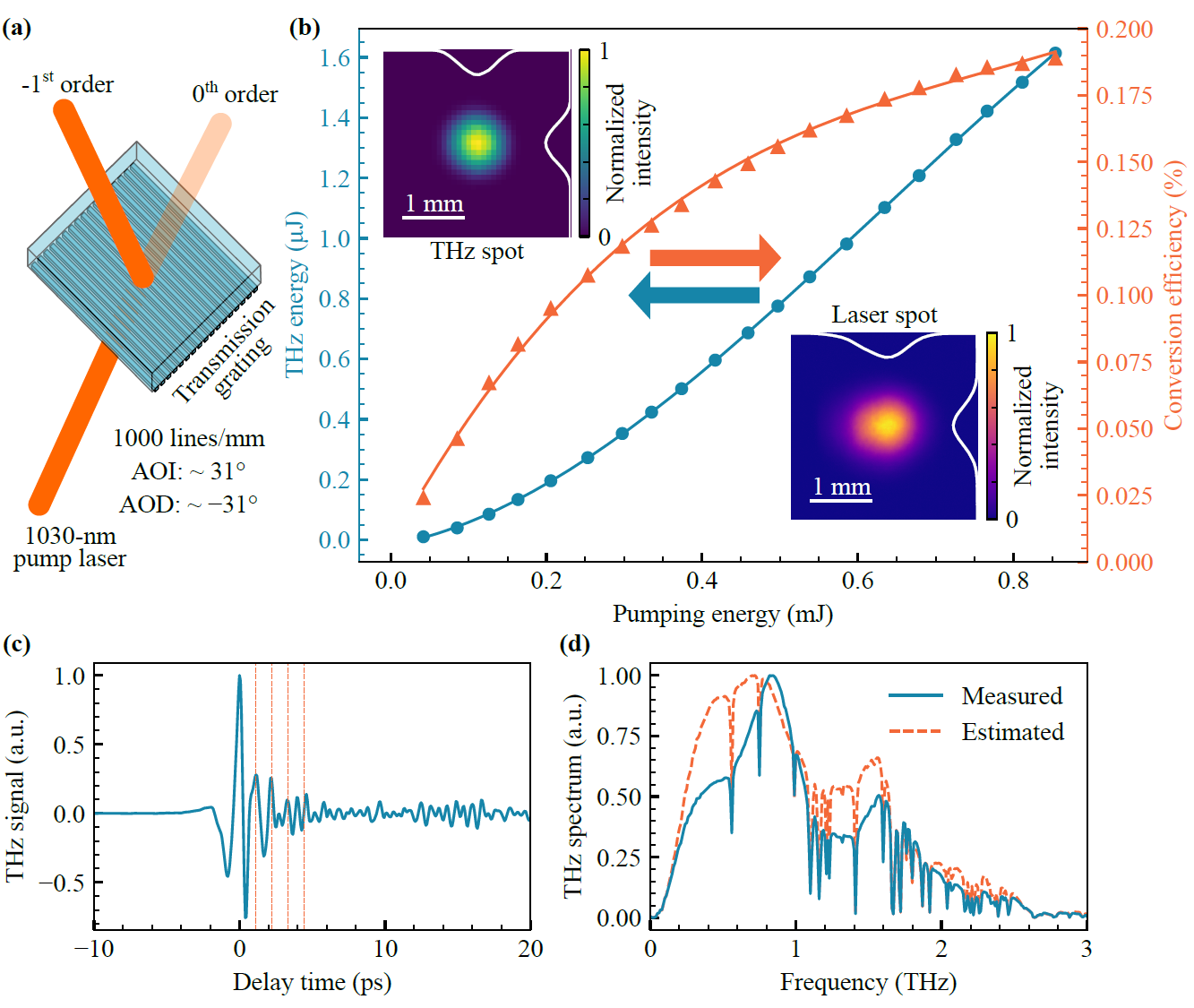
Figure 2: THz generation using a transmission grating. (a) Schematic diagram of grating parameters and configuration; (b) dependence of THz single-pulse energy and conversion efficiency on pumping single-pulse energy, with insets showing focused THz spots and laser spots; (c) typical THz time-domain waveform and (d) the corresponding spectrum.
Figure 2 shows the experimental results of THz generation using the transmission grating-type TPF technique. The groove density of the grating is 1,000 lines/mm. The pump laser is steered by two mirrors to strike the grating at the Littrow Angle (31°) and then direct the -1-order diffracted beam to the imaging system. The grating diffraction efficiency exceeds 95%. To minimize the influence of laser power on THz output, THz characterization was carried out at a repetition rate of 1kHz. As shown in Figure 2 (b), at pump pulse energy of 0.85mJ, the generated THz single-pulse energy reaches 1.6μJ, corresponding to a conversion efficiency of 0.2%. Figure 2 (c) shows a typical THz time-domain waveform recorded under atmospheric conditions. The corresponding spectral distribution is shown in Figure 2 (d), with a frequency range of 0.1-2.5 THz. Figure 1 (b) presents the THz focal spot. By combining the THz time-domain waveform and single-pulse energy, the peak focused THz electric field is estimated to be around 466kV/cm.
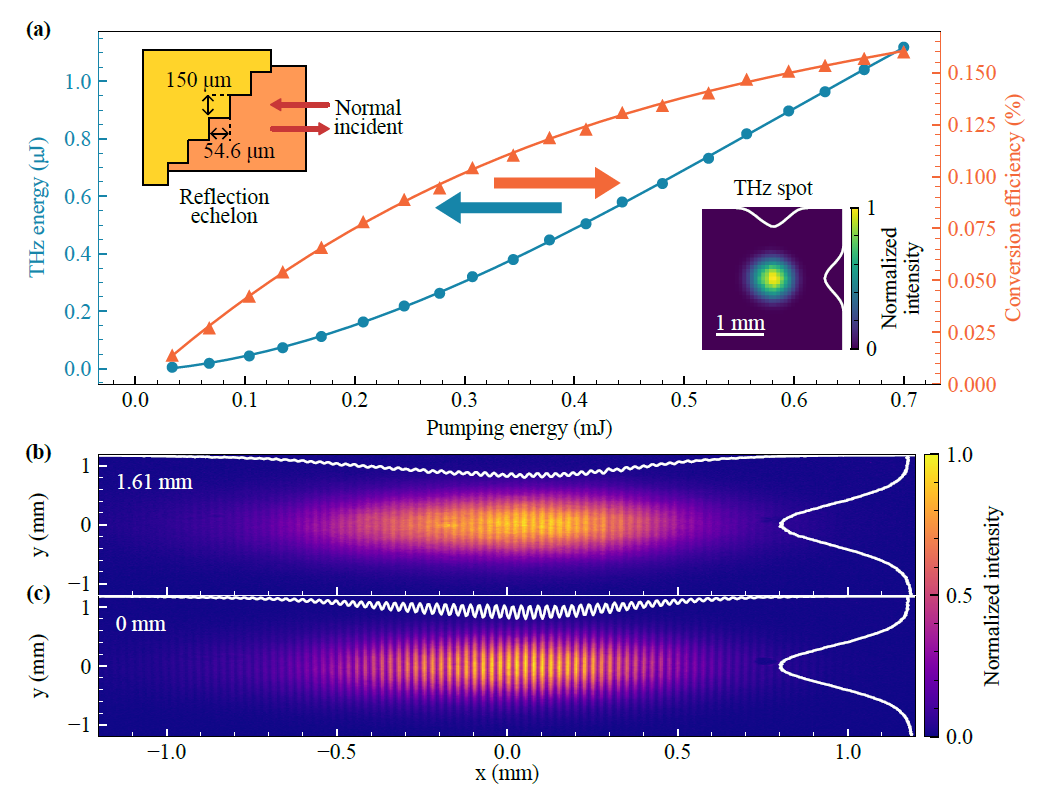
Figure 3: Characterization of the THz output from reflective echelon mirrors. (a) THz single-pulse energy and conversion efficiency as functions of pump energy; (b) laser spot on the crystal’s input surface; and (c) laser spot with the maximum contrast.
To evaluate whether the TPF technique using a reflective echelon mirror is more suitable for the generation of THz through long-pulse, high-power laser pumping, a comparative study was conducted on such a mirror. In this experiment, each echelon mirror is 150μm wide and 54.6μm high. Instead of the conventional oblique incidence scheme, the idea of using an optical isolator was introduced. This enabled normal incidence of the laser, avoiding the distortion of pumping spots in case of tilted beams. Owing to the low reflectivity of the echelon mirrors in this scheme, the maximum pump energy was only 0.7mJ, while the maximum THz single-pulse energy obtained is 1.1μJ, corresponding to a conversion efficiency of 0.16% and the peak electric field of 422kV/cm, lower than the values achieved with the grating scheme.
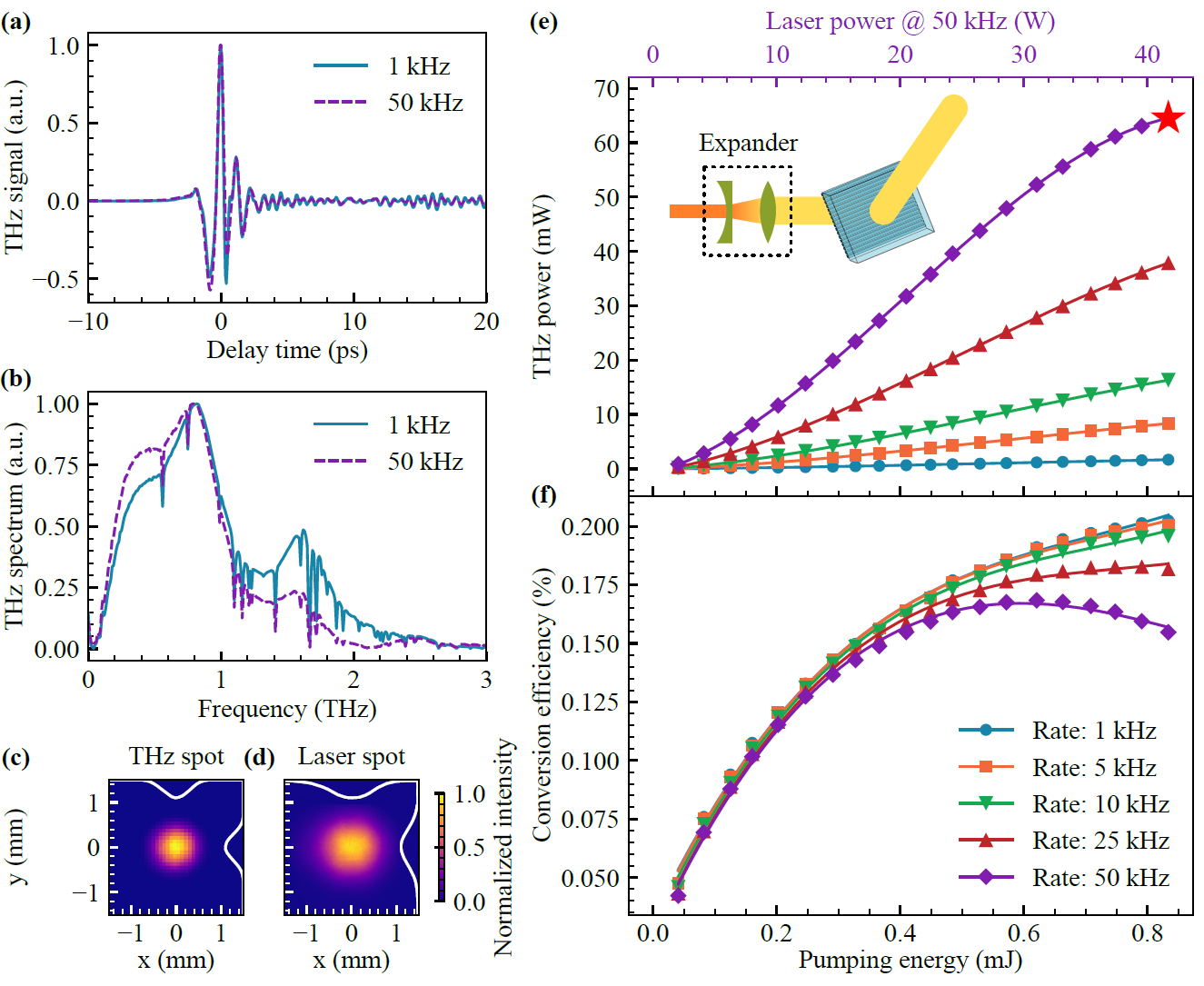
Figure 4: Characterization of THz output performance under high-power pumping. (a) THz time-domain waveforms at repetition rates of 1kHz and 50kHz; (b) corresponding spectrum; (c) THz focal spot and laser spot; (e) THz power curve; and (f) THz efficiency curve.
To achieve high-average-power THz output while avoiding crystal damage, we expanded the pump beam and optimized the grating-type scheme, resulting in an average power of 64.5mW at the focus of the collection paraboloid (see Figure 4 (e)). At a repetition rate of 50kHz, the efficiency decreased at the maximum pump energy, but the THz energy continued to climb, indicating that still higher output should be attainable with larger single-energy pumping. To demonstrate the application of strong-field THz, we monitored its magnetic field component through the Zeeman torque of CoFe, overcoming the distortion of strong-field THz time-domain waveforms caused by the over-rotation effect of ZnTe detection crystals. This laid the foundation for subsequent THz time-domain spectroscopy and imaging applications.
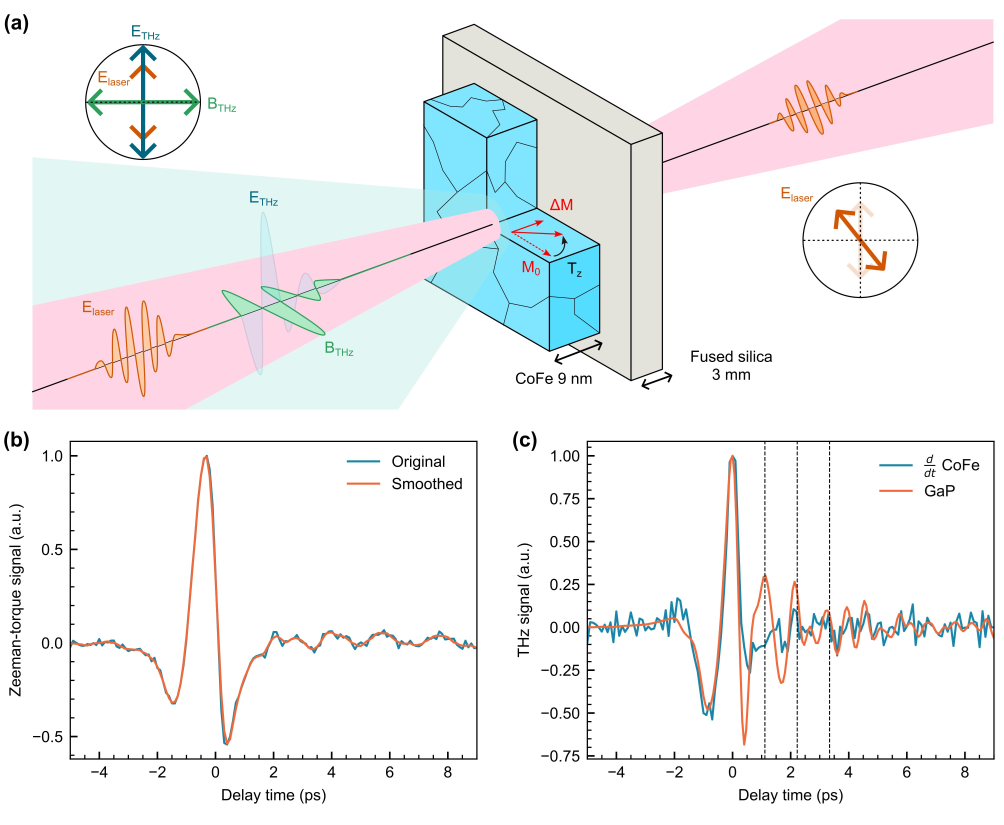
Figure 5: Experimental demonstration of strong-field THz applications. (a) Schematic diagram of Zeeman torque-based detection of strong-field THz magnetic-field components; (b) detection signals of magnetic-field components; and (c) comparison of magnetic-field components and electric-field components.
Dedicated to THz science and dismantling technical barriers, TIRC continues to explore the frontier and write new chapters in scientific research by solving problems with action and innovation!
Approved by Dong Zhuoning, Zhang Wei, Xu Ran
Edited by Yuan Xiaohui

